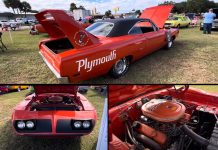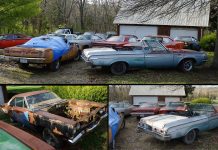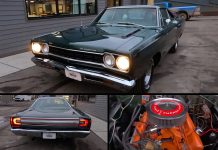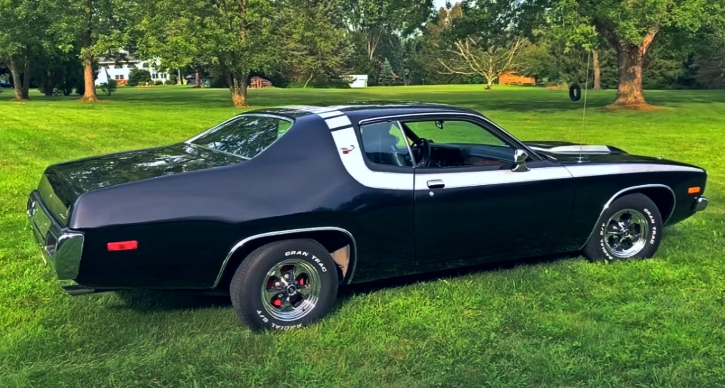Introduced in 1970, the third-generation Plymouth Barracuda stands out as the most iconic model of the lineup. Sporting a sleeker look and featuring Chrysler’s powerhouse engines, the 440-cubic-inch (7.2-liter) RB and the 426-cubic-inch (7.0-liter) HEMI, it marked a significant evolution.
![]()
![]()
In the years 1970 and 1971, the Plymouth HEMI ‘Cuda, an optional variant, became a rarity and a prized possession in today’s market. Convertible models, especially, are elusive and command prices in the millions, whether in Concours condition or in their original state.
While not as renowned, the second-gen Barracuda also boasted the HEMI and the 440 RB engines. Notably, a limited-edition 1968 HEMI Barracuda, codenamed B029, was crafted for the Super Stock class, with only 50 units produced.
![]()
In 1969, the 440 engine made its way into the second-gen Barracuda, not as a standard option but inspired by Mr. Norm’s Grand Spaulding dealerships. This unique offering was extended to a select group of 340 customers.
The pinnacle of uniqueness lies in the “HEMI Under Glass” Barracuda, affectionately known as HUG. Though not a factory Mopar creation, these exhibition drag racing cars by Hurst Performance in the late 1960s and early 1970s hold a special place among muscle car enthusiasts.
![]()
The HUGs served as platforms for showcasing innovative ideas. One such concept involved placing a 426 HEMI V8 at the rear axle, visible through the massive rear window of the second-gen Barracuda. The unconventional design aimed to enhance torque and traction for quicker acceleration.
Initially met with disappointment due to unexpected nose-up tendencies, the HEMI Under Glass took an unexpected turn. The drag racing community’s enthusiastic response led Hurst to transform these cars into “wheel standers,” running quarter-miles with front wheels in the air, captivating audiences for nearly a decade.
![]()
Fast forward to 2023, and some “HEMI Under Glass” Mopars continue to make appearances at events. The 1969 Barracuda version, recently seen at the 2023 Mopars with Big Daddy, showcased its rear-mounted 426 V8, producing over 500 horsepower.
While refraining from its infamous wheel-standing runs, the “HEMI Under Glass” treated spectators to the thunderous sound of its powerful HEMI engine, emitting a fierce roar through its side-exiting exhaust pipes.
![]()
![]()
In 2016, this iconic car gained attention when driver Bob Riggle flipped it multiple times during the taping of an episode of Jay Leno’s Garage. Both Riggle and Jay Leno emerged unharmed, and the car was rebuilt, adding another chapter to its storied history.
# FAQs: Unveiling Details About the Plymouth Barracuda
**Q1: What is the significance of the third-generation Plymouth Barracuda?**
A1: Introduced in 1970, the third-gen Barracuda is considered the most iconic, featuring a sportier design and powerful Chrysler big-block V8 engines.
**Q2: What makes the Plymouth HEMI ‘Cuda rare and expensive?**
A2: The HEMI ‘Cuda, offered as an option in 1970 and 1971, is both rare and expensive today, especially the convertibles, which can cost millions in Concours or unrestored condition.
**Q3: Are there noteworthy variants of the second-gen Barracuda?**
A3: Yes, the second-gen Barracuda includes gems like the limited-edition 1968 HEMI Barracuda (B029) and the 440 RB engine option offered to 340 customers in 1969.
**Q4: What is the “HEMI Under Glass” Barracuda, and why is it special?**
A4: The “HEMI Under Glass” or HUG is a series of exhibition drag racing cars by Hurst Performance, showcasing innovative ideas, such as placing a 426 HEMI V8 at the rear axle. Despite not being factory Mopars, they are celebrated as golden-era muscle cars.
**Q5: How did the HEMI Under Glass gain its name?**
A5: The name originated from the placement of the HEMI engine under the glass rear window of the second-gen Barracuda, a design aimed at improving torque and traction.
**Q6: What happened during the incident involving Bob Riggle and Jay Leno in 2016?**
A6: In 2016, during the taping of Jay Leno’s Garage, driver Bob Riggle flipped the “HEMI Under Glass” multiple times. Both emerged unscathed, and the car was rebuilt. The incident is documented in the third video below.














